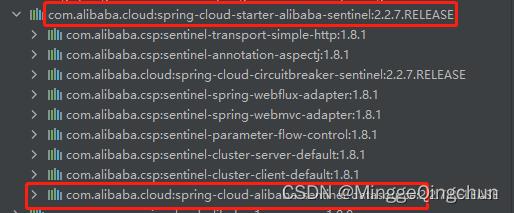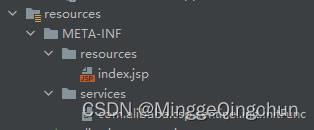SpringCloud - Spring Cloud Alibaba 之 Gateway 集成Sentinel
Posted MinggeQingchun
tags:
篇首语:本文由小常识网(cha138.com)小编为大家整理,主要介绍了SpringCloud - Spring Cloud Alibaba 之 Gateway 集成Sentinel相关的知识,希望对你有一定的参考价值。
阅读本文前可先参考
SpringCloud - Spring Cloud 之 Gateway网关(十三)_MinggeQingchun的博客-CSDN博客_spring.cloud.gateway.routes[0]
SpringCloud - Spring Cloud Alibaba 之 Sentinel 规则持久化(十)_MinggeQingchun的博客-CSDN博客
一、Gateway 集成Sentinel
Gateway网关集成Sentinel是为了流控、熔断、降级
1、添加 sentinel-spring-cloud-gateway-adapter 依赖
<!-- sentinel-spring-cloud-gateway-adapter
Gateway集成Sentinel
-->
<dependency>
<groupId>com.alibaba.csp</groupId>
<artifactId>sentinel-spring-cloud-gateway-adapter</artifactId>
<version>1.8.0</version>
</dependency>2、添加sentinel控制台配置
#sentinel dashboard管理后台
spring:
cloud:
sentinel:
eager: true
transport:
dashboard: 192.168.172.128:80803、在配置类spring容器中配置一个Sentinel的全局过滤器
@Configuration
public class GatewayConfiguration
//省略号代表其它配置
......
@Bean
@Order(-1)
public GlobalFilter sentinelGatewayFilter()
return new SentinelGatewayFilter();
......
4、启动测试
(1)启动Nacos(如果使用mysql数据持久化,则要先启动mysql服务)
cd /opt/software/nacos/bin/
sh startup.sh -m standalone启动MySQL服务(如果docker启动,先启动docker并挂载mysql,防止数据丢失)
http://192.168.133.129:8848/nacos
(2)启动Sentinel DashBoard控制台
cd /opt/software/sentinel-dashboard-1.8.4/
java -jar sentinel-dashboard-1.8.4.jarhttp://192.168.133.129:8080/
(3)分别启动服务提供者、服务消费者
(4)启动Spring Cloud Gateway
(5)浏览器输入访问
http://localhost:8081/test
二、Spring Cloud Gateway集成Sentinel规则持久化
一、使用SPI配置
1、在application.properties中配置依赖
<!--sentinel-datasource-extension数据源扩展-->
<dependency>
<groupId>com.alibaba.csp</groupId>
<artifactId>sentinel-datasource-extension</artifactId>
</dependency>由于之前添加过了 spring-cloud-starter-alibaba-sentinel 依赖,包含了 sentinel-datasource 依赖,此处可以不加

2、自定义 FileDataSourceInit 类 实现 InitFunc(配置文件暂时不动)
import com.alibaba.csp.sentinel.command.handler.ModifyParamFlowRulesCommandHandler;
import com.alibaba.csp.sentinel.datasource.*;
import com.alibaba.csp.sentinel.init.InitFunc;
import com.alibaba.csp.sentinel.slots.block.authority.AuthorityRule;
import com.alibaba.csp.sentinel.slots.block.authority.AuthorityRuleManager;
import com.alibaba.csp.sentinel.slots.block.degrade.DegradeRule;
import com.alibaba.csp.sentinel.slots.block.degrade.DegradeRuleManager;
import com.alibaba.csp.sentinel.slots.block.flow.FlowRule;
import com.alibaba.csp.sentinel.slots.block.flow.FlowRuleManager;
import com.alibaba.csp.sentinel.slots.block.flow.param.ParamFlowRule;
import com.alibaba.csp.sentinel.slots.block.flow.param.ParamFlowRuleManager;
import com.alibaba.csp.sentinel.slots.system.SystemRule;
import com.alibaba.csp.sentinel.slots.system.SystemRuleManager;
import com.alibaba.csp.sentinel.transport.util.WritableDataSourceRegistry;
import com.alibaba.fastjson.JSON;
import com.alibaba.fastjson.TypeReference;
import java.io.File;
import java.io.IOException;
import java.util.List;
/**
* 规则持久化
*/
public class FileDataSourceInit implements InitFunc
@Override
public void init() throws Exception
//可以根据需要指定规则文件的位置
//"user.home" 即C盘 C:\\Users\\用户名 下
String ruleDir = System.getProperty("user.home") + "/sentinel/rules";
String flowRulePath = ruleDir + "/flow-rule.json";
String degradeRulePath = ruleDir + "/degrade-rule.json";
String paramFlowRulePath = ruleDir + "/param-flow-rule.json";
String systemRulePath = ruleDir + "/system-rule.json";
String authorityRulePath = ruleDir + "/authority-rule.json";
this.mkdirIfNotExits(ruleDir);
this.createFileIfNotExits(flowRulePath);
this.createFileIfNotExits(degradeRulePath);
this.createFileIfNotExits(paramFlowRulePath);
this.createFileIfNotExits(systemRulePath);
this.createFileIfNotExits(authorityRulePath);
//以下代码从官网拷贝过来
// 流控规则:可读数据源
ReadableDataSource<String, List<FlowRule>> flowRuleRDS = new FileRefreshableDataSource<>(
flowRulePath,
flowRuleListParser
);
// 将可读数据源注册至FlowRuleManager
// 这样当规则文件发生变化时,就会更新规则到内存
FlowRuleManager.register2Property(flowRuleRDS.getProperty());
// 流控规则:可写数据源
WritableDataSource<List<FlowRule>> flowRuleWDS = new FileWritableDataSource<>(
flowRulePath,
this::encodeJson
);
// 将可写数据源注册至transport模块的WritableDataSourceRegistry中
// 这样收到控制台推送的规则时,Sentinel会先更新到内存,然后将规则写入到文件中
WritableDataSourceRegistry.registerFlowDataSource(flowRuleWDS);
// 降级规则:可读数据源
ReadableDataSource<String, List<DegradeRule>> degradeRuleRDS = new FileRefreshableDataSource<>(
degradeRulePath,
degradeRuleListParser
);
DegradeRuleManager.register2Property(degradeRuleRDS.getProperty());
// 降级规则:可写数据源
WritableDataSource<List<DegradeRule>> degradeRuleWDS = new FileWritableDataSource<>(
degradeRulePath,
this::encodeJson
);
WritableDataSourceRegistry.registerDegradeDataSource(degradeRuleWDS);
// 热点参数规则:可读数据源
ReadableDataSource<String, List<ParamFlowRule>> paramFlowRuleRDS = new FileRefreshableDataSource<>(
paramFlowRulePath,
paramFlowRuleListParser
);
ParamFlowRuleManager.register2Property(paramFlowRuleRDS.getProperty());
// 热点参数规则:可写数据源
WritableDataSource<List<ParamFlowRule>> paramFlowRuleWDS = new FileWritableDataSource<>(
paramFlowRulePath,
this::encodeJson
);
ModifyParamFlowRulesCommandHandler.setWritableDataSource(paramFlowRuleWDS);
// 系统规则:可读数据源
ReadableDataSource<String, List<SystemRule>> systemRuleRDS = new FileRefreshableDataSource<>(
systemRulePath,
systemRuleListParser
);
SystemRuleManager.register2Property(systemRuleRDS.getProperty());
// 系统规则:可写数据源
WritableDataSource<List<SystemRule>> systemRuleWDS = new FileWritableDataSource<>(
systemRulePath,
this::encodeJson
);
WritableDataSourceRegistry.registerSystemDataSource(systemRuleWDS);
// 授权规则:可读数据源
ReadableDataSource<String, List<AuthorityRule>> authorityRuleRDS = new FileRefreshableDataSource<>(
authorityRulePath,
authorityRuleListParser
);
AuthorityRuleManager.register2Property(authorityRuleRDS.getProperty());
// 授权规则:可写数据源
WritableDataSource<List<AuthorityRule>> authorityRuleWDS = new FileWritableDataSource<>(
authorityRulePath,
this::encodeJson
);
WritableDataSourceRegistry.registerAuthorityDataSource(authorityRuleWDS);
private Converter<String, List<FlowRule>> flowRuleListParser = source -> JSON.parseObject(
source,
new TypeReference<List<FlowRule>>()
);
private Converter<String, List<DegradeRule>> degradeRuleListParser = source -> JSON.parseObject(
source,
new TypeReference<List<DegradeRule>>()
);
private Converter<String, List<SystemRule>> systemRuleListParser = source -> JSON.parseObject(
source,
new TypeReference<List<SystemRule>>()
);
private Converter<String, List<AuthorityRule>> authorityRuleListParser = source -> JSON.parseObject(
source,
new TypeReference<List<AuthorityRule>>()
);
private Converter<String, List<ParamFlowRule>> paramFlowRuleListParser = source -> JSON.parseObject(
source,
new TypeReference<List<ParamFlowRule>>()
);
private void mkdirIfNotExits(String filePath) throws IOException
File file = new File(filePath);
if (!file.exists())
file.mkdirs();
private void createFileIfNotExits(String filePath) throws IOException
File file = new File(filePath);
if (!file.exists())
file.createNewFile();
private <T> String encodeJson(T t)
return JSON.toJSONString(t);
3、配置SPI(Service Provider Interface,JDK内置的一种服务提供发现机制,可以用来启用框架扩展和替换组件)
Java SPI是一种以接口为基础,使用配置文件来加载(或称之为服务发现)的动态加载机制,主要使用JDK中ServiceLoader来实现
(1)在classPath下 resources 创建路径META-INF/services/目录下 创建一个 文件 com.alibaba.csp.sentinel.init.InitFunc(以接口的全路径做为名称,不要带文件格式后缀)
(2)将自定义的类 包路径名拷贝至此(实现类的全路径)



4、启动消费者服务,此时去 Sentinel DashBoard中创建一条流控规则
 根据自定义类 FileDataSourceInit 中 存放sentinel 规则的文件夹,
根据自定义类 FileDataSourceInit 中 存放sentinel 规则的文件夹,
即 C:\\Users\\用户名\\sentinel\\rules 可找到相应Sentinel 规则持久化的JSON文件
//可以根据需要指定规则文件的位置
//"user.home" 即C盘 C:\\Users\\用户名 下
String ruleDir = System.getProperty("user.home") + "/sentinel/rules";
二、使用Nacos配置
1、添加sentinel-datasource-nacos依赖;
<!--sentinel数据持久化-->
<dependency>
<groupId>com.alibaba.csp</groupId>
<artifactId>sentinel-datasource-nacos</artifactId>
</dependency>2、application.properties配置持久化数据源
#配置sentinel规则持久化到nacos
datasource:
ncs1:
nacos:
server-addr: 192.168.133.128:80
data-id: $spring.application.name.json
group-id: DEFAULT_GROUP
rule-type: flow
data-type: json
degrade:
nacos:
server-addr: 192.168.133.128:80
data-id: $spring.application.name-degrade.json
group-id: DEFAULT_GROUP
rule-type: degrade
data-type: json3、在nacos配置中心配置流控规则
[
"resource": "abc",
"controlBehavior": 0,
"count": 1.0,
"grade": 1,
"limitApp": "default",
"strategy": 0
]三、Sprng Cloud Gateway跨域CORS
可参考 https://blog.csdn.net/MinggeQingchun/article/details/125538531
传统的Ajax请求只能获取在同一个域名下的资源,但是html5规范中打破了这种限制,允许Ajax发起跨域的请求(需要设置一下)
其实浏览器本身是可以发起跨域请求的,比如你可以链接一个另一个域名下的图片或者js,比如<img src=http://www.baidu.com/image/logo.png>,但是javascript脚本是不能获取这些另一个域名下的资源内容的
CORS是一个W3C标准,全称是”跨域资源共享”(Cross-origin resource sharing),允许浏览器向跨源服务器,发出XMLHttpRequest请求,从而克服了AJAX只能同源使用的限制
这种CORS使用了一个额外的HTTP响应头来赋予当前user-agent(浏览器)获得跨域资源的权限,这里的跨域也就是Cross-Origin的概念,这里的权限就是访问另一个域名下的资源权限
CORS是现在HTML5标准中的一部分,在大部分现代浏览器中都有所支持,可能在某些老版本的浏览器不支持CORS,如果要兼容一些老的浏览器版本,则需要采用JSONP进行跨域请求
同源与非同源(跨域和不跨域)
如果 访问协议、端口(如果指定了端口)、host 都相同,则称之为同源(不跨域),否则为非同源(跨域)
如源链接: http://shop.company.com/good/page.html
| URL | 是否同源 | 原因 |
| 是 | ||
| 是 | ||
| 否 | 协议不同 | |
| 否 | 端口不同 | |
| 否 | host不同 |
解决跨域:
/**
* 配置网关跨域cors请求支持
*/
@Configuration
public class CorsConfig
@Bean
public CorsWebFilter corsFilter()
CorsConfiguration config = new CorsConfiguration();
config.addAllowedMethod("*"); //是什么请求方法,比如 GET POST PUT DELATE .....
config.addAllowedOrigin("*"); //来自哪个域名的请求,*号表示所有
config.addAllowedHeader("*"); //是什么请求头
UrlBasedCorsConfigurationSource source = new UrlBasedCorsConfigurationSource(new PathPatternParser());
source.registerCorsConfiguration("/**", config);
return new CorsWebFilter(source);
以上是关于SpringCloud - Spring Cloud Alibaba 之 Gateway 集成Sentinel的主要内容,如果未能解决你的问题,请参考以下文章